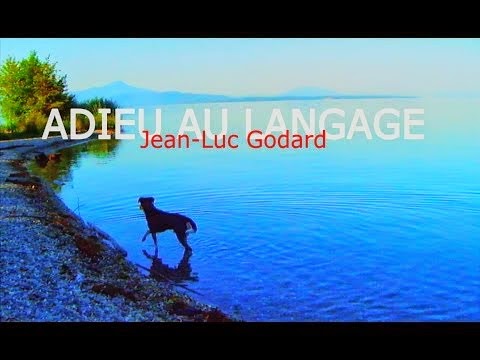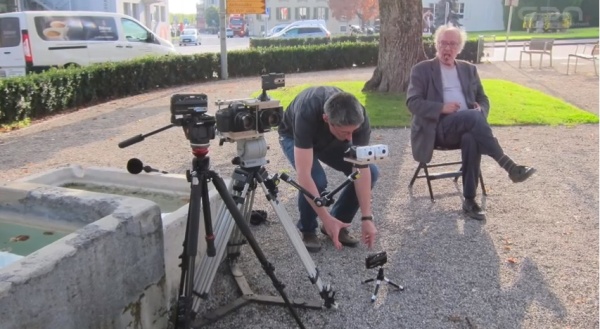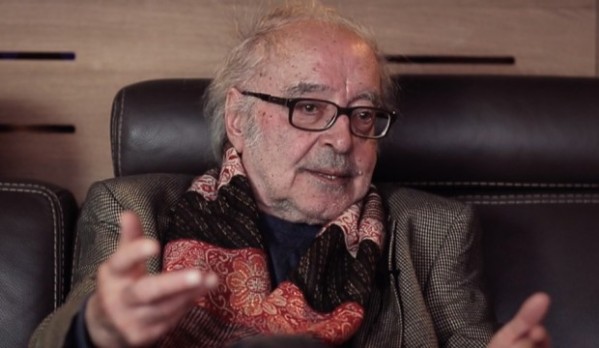Not so long ago I wrote about some of Ken Jacob’s stereoscopic films. Similar to his other avant-garde work, these films eschew smooth, realist representation of the world as we know it in favour of fragmented, disruptive and contemplative reflections on our visual processes. Unsurprisingly, now that Jean-Luc Godard has got his hands on stereoscopy, he is on a similar path. Even more so than Jacobs, his new feature film Goodbye to Language (2014) is about the displeasures of viewing and the impossibility of knowing through sight.
Godard’s earlier film, Week End (1967) is still used as a textbook example of how films can alienate and assault viewers. University students across the world are shown it as an example of the way our passive acceptance of moving images can be turned upside down. Plot development is refused, the audience is addressed directly and we are reminded of the fictiousness of all that we see. Even though most students hate it (including those that later come to vehemently love it) Week End is still used more than 40 years later as a successful counterpoint to the dominant tendency in Hollywood to immerse us in its fictions. Goodbye to Language continues many of Week End’s stylistic tendencies but presents them afresh through the use of stereoscopy to function as a new alienating rather than immersive technology.
At the beginning of the film, white text rests around the plane of the screen’s surface, demonstrating the old elaboration of text in 2D cinema while bold red letters spell out ADIEU in overt negative parallax space. Because of their separation in different depth planes, the red text does not so much obscure the old order text as point to the palimpsest layering that takes place throughout the film. This is enforced a few seconds later when we see ‘2D’ placed somewhere deep in the screen space while ‘3D’ jumps towards us. The temporary and unstable nature of this optical illusion is complemented by a sound track that cuts out and abruptly shifts from one side of the auditorium to the next. It is not only painful to listen to but also makes the audiovisual experience continuously uncertain so that we are never quite sure what we are hearing or seeing. At one point a girl drinks from a cup of water and we seem to be seeing the stereoscopic image laid bare. Rather than one, three-dimensional image, we see two overlapping images as if we were seeing the parallax separation sans glasses even though the glasses are still firmly fixed on our faces. This is just one part of the various layering illusions in which nothing is fixed or stable.
Throughout this experience sight becomes painful. While previous films such as Week End made the viewing process displeasurable through abrupt edits, harassing sound fields and a refusal to develop a straightforward narrative, Goodbye to Language does all of this as well as invoke our bodily frontiers to strain the very muscles in our eyes. By using extreme parallax separation (that often makes objects appear frightening close to us in the auditorium) our eyes are forced to focus and converge at the limits of their ability. At a few times this tendency is taken to an extreme not seen before in 3D cinema. During a single shot, one camera shifts from its alignment with the other camera and follows a new visual path to a completely different part of the scene. In this moment, each eye is given an entirely different image and cannot resolve the two together (even though the eyes will try to do so). The only way to make visual sense of the scene is to close one eye in order to gain a clear view whilst forfeiting visual knowledge of the events being presented to the other eye. If palimpsest layering is one of the visual tools most likely to encourage a haptic, tactile, sense of vision in spectatorship, this form of compositing images produces a type of ultra haptic that is both fascinating and almost completely unbearable.
Yet, for all that Godard is ahead of his time with his experiments in 3D, he is still a director that came of age in post-war Europe and this is no more obvious than in his depictions of the female body. There is one couple that is frequently returned to throughout the film: two conflicted and simultaneously indifferent people, lovers in an extramarital affair. This male and female are seen in various rooms of a domestic setting and, similar to characters in other Godard films, they ponder, swear, muse, defecate, squabble and fart. Frequently they are semi-clothed or nude but it is the woman whose body parts are continuously exposed to the cameras. Her breasts hang out of her dressing gown or her belly and pubic hair bulge towards the viewer. Her male partner, with the appendage that is most likely to ‘poke the viewer in the eye,’ so to speak, is more fully clothed or his nakedness is hidden amongst the recesses of positive parallax space. At one point, standing naked in the kitchen as he exits with his dressing gown on, she says to him “you can’t call this equality” but it isn’t clear if the film understands the problem that its female character is vocalising. Neither of their bodies are particularly erotic as the extreme parallax separation makes these bodies painful to view but it nonetheless seems a relic of the twentieth century that the female body is more fully exposed than her male counterpart in this new form of sight.
While there is much more to be said about the content of the film, I will leave that to those who can contextualise more fully the themes and visually images that link this film with Godard’s past work. What is most interesting about this film for me, and an aspect that places it far closer to Jacob’s work than any contemporary mainstream 3D film, is the extent to which it would be entirely different if seen in a ‘flat’ version. Most commercial 3D filmmakers are aware that their film will also be screened in a variety of 2D formats (in the movie theatre, on DVD or Blu-ray in the home, on the airplane screen) and so limit the extent of their 3D visuality so that it doesn’t disrupt or prevent the 2D version from making sense. This does not mean that their 3D versions are equal to or can be reduced to the same visual experience as the 2D film but stereoscopy is often an enhancement and heightening of the visual processes that are already at work. In Goodbye to Language, on the other hand, the palimpsest layering that occurs throughout the film would be unavailable in 2D and the images would have a completely different type of resonance. We also see things not seen in other 3D films. It is only the second film I have seen (Cave of Forgotten Dreams (2011) was the first) that turns the cameras upside down, throwing askew our perception of where we are situated in relation to the images. Its obscene, insistent placement of objects within our auditorium space goes much further than other films, constantly making it clear that all of this is only an illusion. As much as it is a traditional stereographer’s nightmare, this film shows us that we need to take our processes of sight seriously and it asks us how we can ever believe in images that are presented to us.




